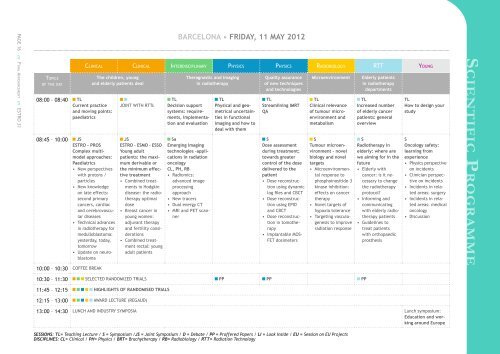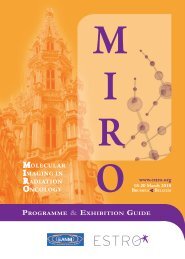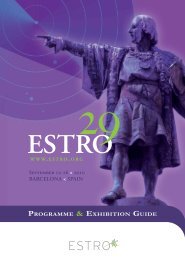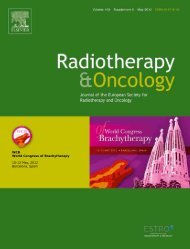9-13 May 2012 • Barcelona, Spain - Estro-events.org
9-13 May 2012 • Barcelona, Spain - Estro-events.org
9-13 May 2012 • Barcelona, Spain - Estro-events.org
You also want an ePaper? Increase the reach of your titles
YUMPU automatically turns print PDFs into web optimized ePapers that Google loves.
BARCELONA <strong>•</strong> FRIDAy, 11 MAy <strong>2012</strong><br />
Scientific<br />
cientific PProgramme<br />
rogramme<br />
clInIcal clInIcal InterdIscIplInary physIcs physIcs radIobIology RTT young<br />
Microenvironment Elderly patients<br />
in radiotherapy<br />
departments<br />
Quality assurance<br />
of new techniques<br />
and technologies<br />
Theragnostic and imaging<br />
in radiotherapy<br />
The children, young<br />
and elderly patients deal<br />
topIcs<br />
oF the day<br />
TL<br />
how to design your<br />
study<br />
TL<br />
Increased number<br />
of elderly cancer<br />
patients: general<br />
overview<br />
TL<br />
Clinical relevance<br />
of tumour microenvironment<br />
and<br />
metabolism<br />
TL<br />
Streamlining IMRT<br />
QA<br />
TL<br />
Physical and geometricaluncertainties<br />
in functional<br />
imaging and how to<br />
deal with them<br />
TL<br />
Decision support<br />
systems: requirements,implementation<br />
and evaluation<br />
TL<br />
Current practice<br />
and moving points:<br />
paediatrics<br />
08:00 – 08:40<br />
JOInT WITH RTTs<br />
S<br />
Oncology safety:<br />
learning from<br />
experience<br />
<strong>•</strong> Physics perspective<br />
on incidents<br />
<strong>•</strong> Clinician perspective<br />
on incidents<br />
<strong>•</strong> Incidents in related<br />
areas: surgery<br />
<strong>•</strong> Incidents in related<br />
areas: medical<br />
oncology<br />
<strong>•</strong> Discussion<br />
S<br />
Radiotherapy in<br />
elderly: where are<br />
we aiming for in the<br />
future<br />
<strong>•</strong> elderly with<br />
cancer: is it necessary<br />
to change<br />
the radiotherapy<br />
protocol?<br />
<strong>•</strong> Informing and<br />
communicating<br />
with elderly radiotherapy<br />
patients<br />
<strong>•</strong> guidelines to<br />
treat patients<br />
with orthopaedic<br />
prosthesis<br />
S<br />
Tumour microenvironment<br />
– novel<br />
biology and novel<br />
targets<br />
<strong>•</strong> Microenvironmental<br />
response to<br />
phosphoinositide-3<br />
kinase inhibition:<br />
effects on cancer<br />
therapy<br />
<strong>•</strong> novel targets of<br />
hypoxia tolerance<br />
<strong>•</strong> Targeting vasculogenesis<br />
to improve<br />
radiation response<br />
S<br />
Dose assessment<br />
during treatment;<br />
towards greater<br />
control of the dose<br />
delivered to the<br />
patient<br />
<strong>•</strong> Dose reconstruction<br />
using dynamic<br />
log files and CbCT<br />
<strong>•</strong> Dose reconstruction<br />
using ePID<br />
and CbCT<br />
<strong>•</strong> Dose reconstruction<br />
in tomotherapy<br />
<strong>•</strong> Implantable MOS-<br />
FeT dosimeters<br />
Sa<br />
Emerging imaging<br />
technologies –applications<br />
in radiation<br />
oncology<br />
CL, Ph, RB<br />
<strong>•</strong> Radiomics:<br />
advanced image<br />
processing<br />
approach<br />
<strong>•</strong> new tracers<br />
<strong>•</strong> Dual energy CT<br />
<strong>•</strong> MRI and PeT scanner<br />
JS<br />
ESTRO – ESMO – ESSO<br />
young adult<br />
patients: the maximum<br />
derivable or<br />
the minimum effective<br />
treatment<br />
<strong>•</strong> Combined treatments<br />
in Hodgkin<br />
disease: the radiotherapy<br />
optimal<br />
dose<br />
<strong>•</strong> breast cancer in<br />
young women:<br />
adjuvant therapy<br />
and fertility considerations<br />
<strong>•</strong> Combined treatment<br />
rectal: young<br />
adult patients<br />
JS<br />
ESTRO - PROS<br />
Complex multimodel<br />
approaches:<br />
Paediatrics<br />
<strong>•</strong> new perspectives<br />
with protons /<br />
particles<br />
<strong>•</strong> new knowledge<br />
on late effects:<br />
second primary<br />
cancers, cardiac<br />
and cerebrovascular<br />
diseases<br />
<strong>•</strong> Technical advances<br />
in radiotherapy for<br />
medulloblastoma:<br />
yesterday, today,<br />
tomorrow<br />
<strong>•</strong> update on neuroblastoma<br />
08:45 – 10:00<br />
10:00 – 10:30 COFFee bReaK<br />
10:30 – 11:30 SeLeCTeD RanDOMIZeD TRIaLS PP PP PP<br />
hIghLIghTS OF RANDOMISED TRIALS<br />
11:45 – 12:15<br />
aWaRD LeCTuRe (RegauD)<br />
12:15 – <strong>13</strong>:00<br />
<strong>13</strong>:00 – 14:30 LunCH anD InDuSTRY SYMPOSIa Lunch symposium:<br />
Education and working<br />
around Europe<br />
SESSIONS: TL= Teaching Lecture / S = Symposium /JS = Joint Symposium / D = Debate / PP = Proffered Papers / LI = Look Inside / EU = Session on EU Projects<br />
DISCIPLINES: CL= Clinical / PH= Physics / BRT= Brachytherapy / RB= Radiobiology / RTT= Radiation Technology<br />
Page 16 /// FInal announcement /// eSTRO 31 eSTRO 31 /// FInal announcement /// Page 17<br />
clInIcal InterdIscIplInary physIcs physIcs radIobIology RTT young<br />
S<br />
ESTRO<br />
contract<br />
with the<br />
young<br />
JOInT<br />
WITH<br />
CLInICIanS<br />
LI<br />
Does fractionated<br />
radiation therapy make<br />
tumours more aggressive?<br />
<strong>•</strong> Radiation induced<br />
changes in cell-cell and<br />
cell-matrix<br />
<strong>•</strong> Vascular and metabolic<br />
responses to tumour<br />
irradiation<br />
<strong>•</strong> TgFbeta: dual roles<br />
in the response of<br />
tumours and normal<br />
tissues to radiation<br />
LI<br />
Tracking: techniques, methods,<br />
dosimetric and QA aspects<br />
<strong>•</strong> Motivation for real-time adaptive<br />
therapy (what problems<br />
are solved, how important is<br />
this potentially, what level of<br />
evidence is there)<br />
<strong>•</strong> approaches for motion detection<br />
and trajectory prediction<br />
<strong>•</strong> Clinical commissioning and clinical<br />
experience of real-time<br />
adaptation<br />
S<br />
Imaging for treatment<br />
assessment<br />
<strong>•</strong> Cone beam CT based<br />
measurement of dose<br />
response in normal lung<br />
<strong>•</strong> Diffusion-weighted MRI<br />
for prediction and early<br />
treatment assessment of<br />
chemoradiation in head<br />
and neck cancer<br />
<strong>•</strong> assessment of head and<br />
neck toxicity using CT<br />
Sb<br />
Emerging imaging<br />
technologies – how<br />
functional imaging<br />
will impact our<br />
practice<br />
CL, Ph, RB<br />
<strong>•</strong> Prostate<br />
<strong>•</strong> brain<br />
<strong>•</strong> Lymphoma<br />
<strong>•</strong> Lung<br />
S<br />
Elderly patients’ treatment:<br />
standards vs. feasibility<br />
<strong>•</strong> The elderly tsunami<br />
<strong>•</strong> Importance of age and comorbidity<br />
for the outcome<br />
radiotherapy in head and<br />
neck cancer. a population<br />
based study<br />
<strong>•</strong> The limits in delivery of chemotherapy<br />
in the elderly:<br />
the breast model<br />
<strong>•</strong> Comprehensive assessment<br />
in elderly patients with<br />
cancer<br />
14:30 – 15:45<br />
15:45 – 16:15 COFFee bReaK Moving<br />
poster<br />
16:15 – 17:15 S<br />
PP S<br />
PP D<br />
PP PP<br />
session<br />
Elderly patients treatment:<br />
Can imaging be<br />
Why should we do pre-treat-<br />
standards vs. feasibility<br />
quantitative?<br />
ment QA for IMRT when we<br />
<strong>•</strong> Primary radiotherapy:<br />
CL, RB<br />
didn’t do it for conformal<br />
head and neck<br />
<strong>•</strong> Multi-centric<br />
therapy?<br />
<strong>•</strong> neoadjuvant radiotherapy:<br />
calibration of PeT<br />
Lower gI<br />
<strong>•</strong> Validation of<br />
<strong>•</strong> adjuvant and definitive<br />
imaging<br />
radiotherapy in elderly<br />
<strong>•</strong> What can automa-<br />
patients with lung cancer<br />
tic PeT tumour volume<br />
delineation<br />
bring to treatment<br />
planning?<br />
17:30 – 18:00 aWaRD LeCTuRe (IRIDIuM) COMPanY aWaRD LeCTuReS (VaRIan, J. FOWLeR)<br />
eSTRO SCHOOL SYMPOSIuM anD ReCePTIOn<br />
18:00 – 19:00<br />
SESSIONS: TL= Teaching Lecture / S = Symposium /JS = Joint Symposium / D = Debate / PP = Proffered Papers / LI = Look Inside / EU = Session on EU Projects<br />
DISCIPLINES: CL= Clinical / PH= Physics / BRT= Brachytherapy / RB= Radiobiology / RTT= Radiation Technology









